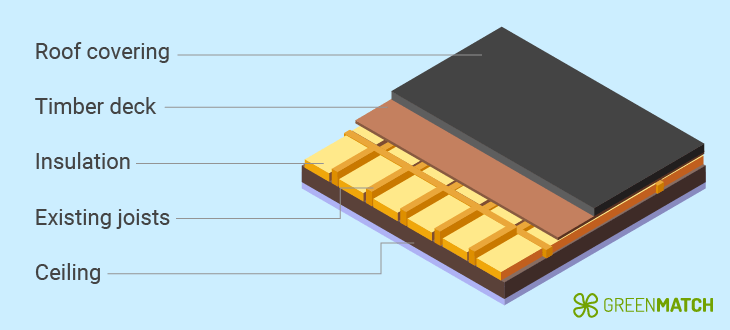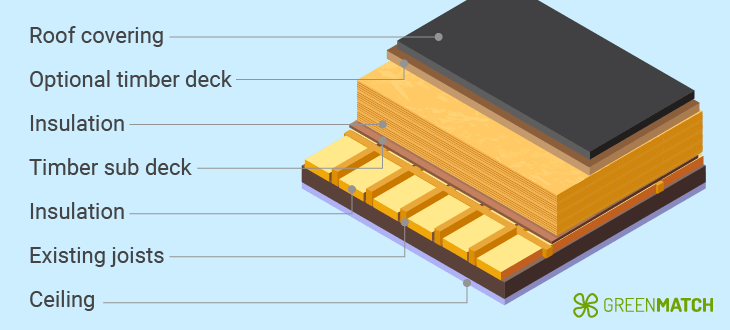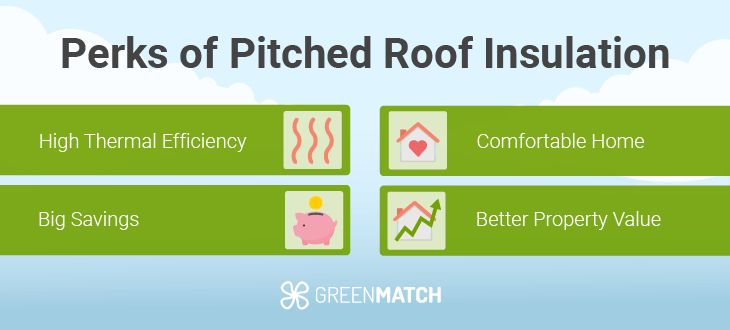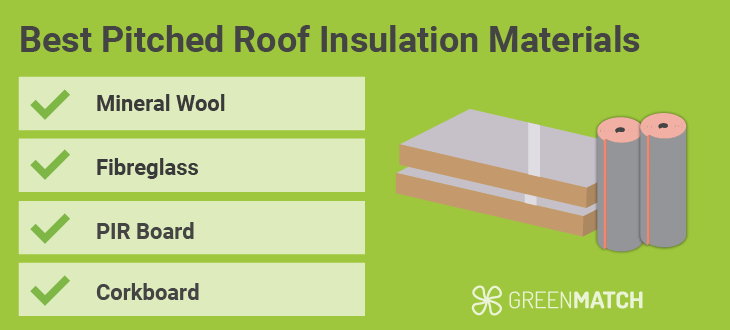Answer these simple questions and we will find you the BEST prices
Which type of solar quotes do you need?
It only takes 30 seconds
100% free with no obligation

Get Free quotes from insulation specialists near you

Save money by comparing quotes and choosing the most competitive offer

The service is 100% free and with no obligation
- GreenMatch
- Insulation
- Roof Insulation
- Pitched Roof Insulation
Pitched Roof Insulation: A Comprehensive Guide (2025)


- Most homes in the UK will have pitched roofs. Their design allows for the natural runoff of rainwater and the creation of a loft space underneath.
- Insulating a standard detached UK home’s pitched roof can cost around £1,100 for a full job, but bring up to £380 in annual energy bill savings.
- Pitched roof and loft insulation have one of the quickest payback periods for your investment, often able to pay itself off in under 5 years.
Pitched roofs are a common find all across the UK’s domestic housing sector. With their iconic style, they effectively help reduce water buildup from rainfall and create the space for a loft conversion underneath.
However, uninsulated pitched roofs are responsible for a staggering 26% of heat loss in a home, leading to soaring energy bills, a damp and drafty home environment, and a carbon footprint that harms the planet.
Luckily, insulation for the roof stands out as a highly affordable, effective, and long-term solution to boost your savings, livelihood, and sustainability. This ultimate guide by GreenMatch UK will provide you with all the necessary information on pitched roof insulation, including styles, pros, cons, and costs.
Ready to insulate your roof? GreenMatch UK is your one-stop solution for all your needs. Instead of spending endless hours researching and vetting installers, spend just 30 seconds filling out our online form and receive up to 3 free home-tailored quotes from our network of trusted professionals. No charges, no obligations. Click the button below to begin!
- Describe your needs
- Get free quotes
- Choose the best offer
It only takes 30 seconds



What is pitched roof insulation?
Pitched roof insulation refers to adding insulation material, either above or below the rafters of a pitched roof. By doing so, the loft space underneath and the rest of the home will experience better thermal enveloping.
Insulation for a pitched roof structure comes with two main approaches. These are called cold-pitched roof insulation, and warm-pitched roof insulation. Both approaches are carried out differently and will depend on your roof structure, whether the job is refurbishing existing insulation, or whether roof tiles will be removed.
Cold pitched roof insulation

Cold-pitched roof insulation is when insulation material is laid in between and below the roof rafters. As such, the roof rafters themselves remain uninsulated, but the space underneath them is insulated.
Cold-pitched roof insulation between rafters also means your roof has a thinner build. While this is not inherently a problem, it does mean you may not be able to maximise the full extent of thermal efficiency your roof insulation could provide.
Nevertheless, cold roof insulation comes with numerous advantages. It is more affordable than warm-pitched roof insulation, it's a simpler job to carry out, and the gap left above the insulation helps to create proper air ventilation, which will keep your insulation material dry for longer.
Warm pitched roof insulation

Warm-pitched roof insulation is when insulation material is laid in between and above the roof rafters. This means that the roof rafters are also insulated, alongside the loft space below.
While this process costs more and requires more labour than cold roof insulation, the key advantage is that your roof will have a thicker build. This allows you to utilise thicker insulation materials, and achieve the highest degree of thermal efficiency for your roof and home.
Benefits of pitched roof insulation

Pitch roof insulation is one of the most cost-effective insulation projects you could carry out on your home. With a wealth of benefits to consider, here are some of the key perks you could enjoy with proper pitched roof insulation:
- High thermal efficiency: With proper roof insulation in place, your heating system will no longer need to overwork to make up for lost heat. This will lead to significant energy bill savings, less carbon emissions, and a much more temperature-regulated home.
- Big savings: With better heat retention in your roof, you can cut your home heat loss by over a quarter, leading to savings of up to £380 on annual energy bills for a detached home.
- Comfortable home: Thermal efficiency will make sure your home is better at retaining its internal temperature, giving you stable comfort. In addition, roof insulation can help reduce condensation and moisture, as well as eliminate mould and rot risks.
- Better property value: Homes with adequate insulation in place are valued much higher on the housing market, should you ever choose to rent out or sell your home.
Speaking of savings, here’s a breakdown of just how much you could expect to save with pitched roof insulation depending on the type of home you have:
| Home type | Average insulation costs (£) |
|---|---|
| Mid-terrace home | £200 |
| Semi-detached home | £230 |
| Detached home | £380 |
| Detached bungalow | £370 |
How to insulate a pitched roof from inside
Insulating pitched roof structures from the inside is called cold-pitched roof insulation. This is when the insulation material is added in between the roof rafters and not above them. It’s a relatively simple process, so let’s take a look:
- Conduct a roof assessment: Make sure to work with a professional roof insulation installer who can assess your situation and provide the most effective course of action to insulate your pitched roof.
- Address any repairs: An installer may notice shortcomings that need to be solved before going ahead with the insulation job. This can include clearing debris, removing outdated insulation, filling gaps, or relocating wiring and other hazards.
- Begin pitched roof insulation: Insulating from the inside of the property will almost always be cold-pitched roof insulation. A professional will secure the chosen insulation material in between the roof rafters, leave at least 50mm of room for ventilation, and possibly add a vapour barrier to protect the material from moisture.
- Finish up: Once the insulation material is in place and secure, final aesthetic touches can be made. This will often include adding plasterboard from the inside of the loft for a seamless finish to the ceiling.
Whether you want cold or warm-pitched roof insulation, it’s highly recommended to work with a professional installer to make sure the job is done right. A shabby DIY sloping roof installation can often turn into a financial burden marred with repair costs. That’s where GreenMatch UK comes in.
Instead of spending countless hours surfing websites and arranging phone calls, just spend 30 seconds filling out our online form and we’ll send you up to 3 free home-tailored quotes from trusted professionals in our network. No charges apply. Click the button below to begin!
- Describe your needs
- Get free quotes
- Choose the best offer
It only takes 30 seconds



Best materials for pitched roof insulation

There is no single best insulation for roof purposes, as your choice will hinge on many factors such as your roof build, any existing insulation, budget, and more.
However, some insulation materials on the market stand out for various reasons. Here’s a rundown of your best options:
- Mineral wool: Made from either rock or wool and costing around £13 - £17.5 per m2, mineral wool is one of the most popular and sustainable insulation materials on the market. Found in blankets or batts, these can be easily cut into desired lengths and fitted in between, above, and below pitched roof rafters.
- Fibreglass: Very similar to mineral wool, fibreglass is made from recycled glass products, and costs just around £10 per m2, making it one of the most affordable insulation materials on the market. They also come as blankets or batts and can be easily fitted. Fibreglass is also quite sustainable in production and can be recycled.
- PIR board: These rigid boards are made of polyisocyanurate, a synthetic polymer with impressive thermal efficiency. Costing around £5 – £15 per m2 depending on the material thickness, these boards are cut into desired lengths and fitted snugly in between roof rafters. They’re particularly renowned for their moisture, flame and mould resistance, as well as their high ability to withstand heat transfer. However, PIR boards are not very sustainable to produce and are not biodegradable.
- Corkboard: A great sustainable alternative to synthetic insulation boards, cork exhibits spectacular heat retention and is also entirely sustainable and recyclable. Costing around £17 - £22 per m2, corkboard can be installed in the same way as any other rigid insulation board.
Consulting a professional installer is the best approach to choosing your insulation material for pitched-roof insulation, as an installer can assess your property and suggest the best fit.
Pitched roof insulation cost
The cost of roof insulation for a standard detached UK home is around £1,100 for a full job. This cost can vary depending on your pitched-roof style, condition, outstanding repairs, chosen insulation materials and much more.
Here’s a breakdown of the average costs for pitched-roof insulation based on the type of property in the UK:
| Home type | Average insulation costs (£) |
|---|---|
| Mid-terrace home | £850 |
| Semi-detached home | £900 |
| Detached home | £1,100 |
| Detached bungalow | £1,200 |
In addition, the insulation material you opt for will have an impact on your overall investment. Insulation material prices vary based on thermal efficiency, production, and availability. We’ve compiled a list of the most common insulation materials and their prices per m2:
| Insulation material | Cost (£/m2) |
|---|---|
| Mineral wool | £13 - £17.5 |
| Fibreglass | £10 |
| PIR board | £5 - £15 |
| Corkboard | £17 - £22 |
Keep in mind that the costs and process for insulating a flat roof differ drastically, mainly because it is not a very common structure in the UK.
There are plenty of options for pitched-roof insulation suited for all types of budgets, home types, and preferences. For qualifying households, there are even UK government insulation grants that can provide free or reduced-cost roof insulation. These are administered through the Great British Insulation Scheme (GBIS) or the Energy Company Obligation (ECO4).
Pitched roof insulation regulations
There are pitched roof insulation regulations in place to ensure that your insulation provides the necessary thermal efficiency, is safely installed, and is effective.
Most regulations imposed on homes and properties are outlined in Part L of the UK’s Building Regulations. Here are some of the key regs that relate to pitched roof insulation jobs:
- Thermal efficiency: Your pitched roof insulation must be able to achieve a U-value of 0.18 W/m²K for a warm roof and 0.13 W/m²K for a cold roof. U-value is the rate at which heat transfer occurs through a material, so a lower U-value indicates a more thermally efficient material.
- Property structure: More specifically for loft conversion jobs, certain regulations in place restrict you from expanding the reach of your roof structure from its existing span, as well as limiting your roof density for the safety and structural integrity of your property.
- Recommended thickness: For pitched roof insulation, and most loft insulation jobs in general, it’s highly recommended to install at least 270mm of blanket-style insulation (e.g. mineral wool, fibreglass) to ensure effective thermal insulation.
Is pitched roof insulation a good solution for your home?
With all things considered, pitched roof insulation is a wonderful home efficiency upgrade that significantly improves your energy bill savings, home comfort, and even domestic carbon footprint, all with a single investment.
In addition, pitched roof insulation is considered one of the most affordable, yet effective home insulation upgrades, often able to pay off your initial investment in just 5 years.
However, deciding to get pitched roof insulation is just the start. Finding the right installer at the right price can often be the more difficult task, requiring endless hours of research and vetting. Luckily, GreenMAtch UK is here to help you.
By spending just 30 seconds filling out our simple online form, you can receive up to 3 free home-tailored quotes from our nationwide network of pre-vetted installers. The best part? Our services are completely free of charges and obligations. Click the button below to begin!
- Describe your needs
- Get free quotes
- Choose the best offer
It only takes 30 seconds



FAQ
Pitched roofs can be insulated through either cold or warm roof insulation. Cold roof insulation is when insulating material is fitted between and under roof rafters, leaving the roof structure itself uninsulated. Warm roof insulation is when insulation material is fitted in between and above the roof rafters, also insulating your roof structure.
Pitched roof insulation is a very worthy investment, cutting your home heat loss by more than a quarter. This leads to energy bill savings, increased home comfort, higher property value, and even an improved carbon footprint.
The best insulation for a pitched roof depends on factors such as your roof type, budget and preferences. From a general standpoint, mineral wool or fibreglass stand out as the most popular insulation materials, due to their affordability and relative thermal efficiency.
The recommended thickness for a pitched roof insulation job is 270mm of mineral wool, fibreglass or similar material. For rigid insulation boards with a higher thermal efficiency, it is possible to install a lesser thickness and still achieve high performance.
Pitched roof insulation for a standard detached UK home costs around 1,100 for a full job. This cost can vary depending on circumstances such as your chosen insulation material, home conditions, installation complexity and more.

Akif is a copywriter at GreenMatch since 2023. With a keen interest in community sustainability, green solutions and the role of digital media in identifying climate trends, he aims to hone in on his background in International Studies and Digital Media to provide a multidisciplinary approach to written content rooted in credible research and accuracy.
We strive to connect our customers with the right product and supplier. Would you like to be part of GreenMatch?

- Pitched Roof Insulation: A Comprehensive Guide (2025)
- What is pitched roof insulation?
- Benefits of pitched roof insulation
- How to insulate a pitched roof from inside
- Best materials for pitched roof insulation
- Pitched roof insulation cost
- Pitched roof insulation regulations
- Is pitched roof insulation a good solution for your home?
- FAQ
